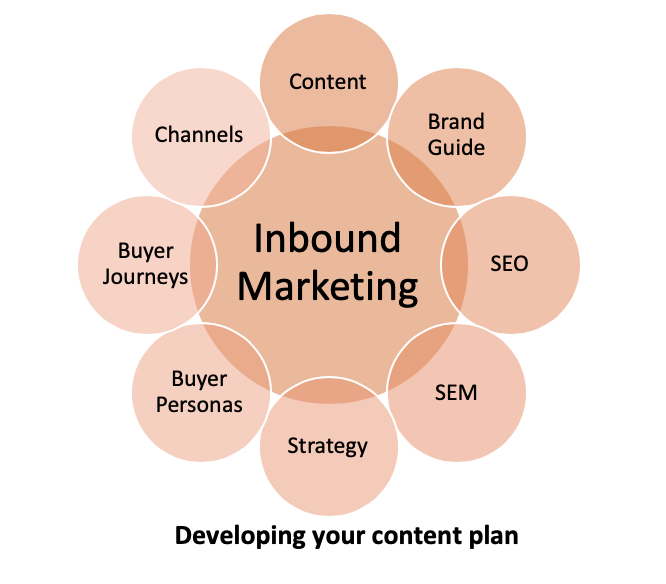Content Marketing – A simple how to guide

So, you’re interested in a planned approach to developing your own content marketing but not sure where to start or, you’ve developed a bunch of content and want to realise a better ROI on your efforts to date?
Whatever your motivation, this article should help you to pull together a plan to make your content more relevant to your target audience, your approach more planned and achieve a better result and conversions on your website or blog.
Develop Your Content Strategy
Don’t write a word of content until you know who you are writing for, what they are looking for and how that relates back to your offerings.
Use buyer personas (we’ll talk about that soon) and buyer journeys (and this too) to understand your ideal customers habits, channel preferences and let that guide your efforts.
Develop a primary topic e.g. “Inbound Marketing” and then sub-topics that link back to that primary topic.

Then you can start developing the content for each of your sub-topics, cross-linking where possible to build up added value for your audience.
Your strategy should also inform which promotional channels to use to boost traffic to your newly created gems like social media or Search Engine Marketing (SEM) Online, or offline.
Then you can develop your content calendar to tie it all together into a planned program of work driven by a planned approach to your area of expertise. You can also drop in other content that might be in response to real-time issues or events to add relevance to your content strategy.
Finally, you should establish the goals for your content strategy. These goals should be SMART based and be tied back to you bigger organisational goals. You should also regularly review progress and tweak your work to measure improvement.
Every piece of content you create should clearly link back to a buyer persona at a specific point on the buyers journey with calls to action leading users closer to a sale and your SMART goals.
Always have a Clear Call to Action
Your subtopic content should all be ungated, that is, freely accessible, by any visitor to your site on their own and cross-linked to each other to build a complete picture of your topic. You should also include a clear call to action on each subtopic post where you offer up all of your content as a complete “Guide” or “e-Book” in exchange for the users details (name, email address, company etc) which we’ll go into more detail on the call to action post.
Headlines win Eyeballs
It doesn’t matter how good your perfectly crafted blog content is, if the headline sucks, it won’t draw readers in like it could do.
There’s a real science to creating great headlines to blog posts. 60 characters or less to ensure it displays well in Google search results. A sprinkling of keywords to increase relevancy and a bracketed offer seems to add intrigue e.g. [downloadable template]
SEO is important, but readers are more important
Yes, it’s important that your blog is appropriately encrusted with keywords relevant to your topic so the search engines love your stuff, but your primary aim should always be to entertain, inform and add value to your target audience.
Google Rank Brain (the search algorithm smarts behind the search box) has become much better at linking keywords and natural language but also takes into account the searchers history and interests, so focus on them first and foremost in your writing and the search engine will do its magic with a little SEO tickle up.
See our SEO primer here.
Quality over Quantity
Don’t pump out crap content because your calendar says so. If you feed your audience with bloat there’s a good chance you will erode your credibility and they simply won’t come back.
There’s an old saying… Crap in = Crap out.
Only publish something that adds value to your audience and is linked to your primary topic. Don’t overpromise in your promotions, the audience should receive exactly what you tell them.
Entertain people
Don’t be afraid to inject a little humour or weirdness into your content, it can make your writing more interesting, personable and relatable. Too many content creators think business should be starched collars and straight ties but that’s just boring!
Have some fun, be brave and be yourself… After all, you want to live up the narrative that you are building up in your content for when you do finally sign-up your new customers eh?
Use the tools and resources
There are loads of tools and resources available to help create great content and ensure that you are sending out your freshest and best work. I follow loads of blogs, staff of marketing agencies on Social Media, conferences etc and they are never-ending sources of inspiration.
There are also tools to help with writing if you are not a super confident writer like me, I use Grammarly to help ensure I use good words, the best words, everybody says so.
Promote your work
There’s nothing quite like posting your content and hitting the publish button, but you shouldn’t stop there.
Once your content is online, you should promote it through your social media, email, whatever…. drive traffic to your freshly minted new post and measure the response. Use your content calendar and tools like Buffer or HubSpot to help.
The trick to promotion is context, use channel specific calls to action and do some A/B testing to improve your response rates.
Ham it up
Don’t be afraid to try new content types to spice things up a little.
If you normally write blogs, try a vlog, or some infographics. Nothing draws people back to your site like a little variety.
Also, for shits and giggles, sprinkle in few links to your other work where it is relevant or externally if adds value for your readers.
Analyze it
This is more important than many people seem to realize. How do you know you are doing a good job if you don’t periodically check your results?
I personally have a few metrics I like to check monthly and I put these into a spreadsheet to track progress and improve my work.
Plus it feels good to see the fruits of your labour!
So there you go, time to flex your creative muscles and get to work on your own content plan.
1 Comment
Comments are closed.


Brad Friis
Great article Ben – thanks!